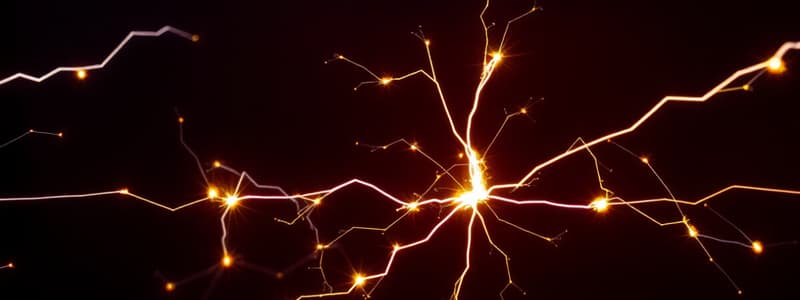Podcast
Questions and Answers
What is electrostatics?
What is electrostatics?
Electrostatics is the study of electric charges at rest under the action of electric forces.
Which methods are used for charging?
Which methods are used for charging?
- Friction or rubbing between dielectric materials (correct)
- Induction method for conductors (correct)
- Conduction method for conductors (correct)
- Grounding for insulators
Similar charges attract each other.
Similar charges attract each other.
False (B)
What happens to electric charges in terms of conservation?
What happens to electric charges in terms of conservation?
The total charge on a body is the __________ sum of the positive and negative charges.
The total charge on a body is the __________ sum of the positive and negative charges.
What is the electron charge (e)?
What is the electron charge (e)?
How many electrons are in one Coulomb of charge?
How many electrons are in one Coulomb of charge?
What is the magnitude of a charge that each of three identical balls has after contact?
What is the magnitude of a charge that each of three identical balls has after contact?
What is the number of electrons in excess or deficit on each ball after contact?
What is the number of electrons in excess or deficit on each ball after contact?
How many electrons were transferred from wool to a polythene piece that has a charge of -3.2 x 10^-7 C?
How many electrons were transferred from wool to a polythene piece that has a charge of -3.2 x 10^-7 C?
Flashcards are hidden until you start studying
Study Notes
Electrostatics
- The study of stationary electric charges and their interactions
- Interactions between stationary charges are governed by Coulomb's Law
Methods of Charging
- Friction: Rubbing two materials together transfers electrons, creating static electricity
- Conduction: Direct contact with a charged object transfers charge
- Induction: Bringing a charged object near a conductor, without contact, redistributes charges
Charge Interactions
- Like charges repel: Charges with the same sign (both positive or both negative) push each other away
- Unlike charges attract: Charges with opposite signs (one positive and one negative) pull towards each other
Conservation of Charge
- Electric charge is conserved: The total amount of electric charge in an isolated system remains constant
- Charge can be transferred, but it is never created or destroyed
Total Charge
- The total charge on a body is the algebraic sum of the positive and negative charges. Positive and negative charges cancel each other out.
Fundamental Charge
- The electron charge (e) is a fundamental unit of charge: -1.602 x 10^-19 Coulombs
- This means charges are quantized, occurring in discrete multiples of 'e'
Coulomb of Charge
- One Coulomb (C) is a large amount of charge: 6.24 x 10^18 electrons
- The number of electrons in one Coulomb of charge is found by dividing 1 Coulomb by the charge of a single electron
Charge Distribution
- When charged objects of equal size and material come into contact, the charge is distributed equally among them
- The magnitude of the charge on each object after contact is equal to the total charge divided by the number of objects
Electron Transfer
- To determine the number of electrons transferred, divide the total charge by the charge of a single electron
- The charge of one electron (e) is -1.602 x 10^-19 Coulombs.
Studying That Suits You
Use AI to generate personalized quizzes and flashcards to suit your learning preferences.




